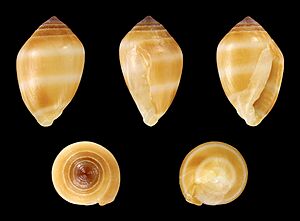Coffee bean snail facts for kids
Quick facts for kids Coffee bean snail |
|
|---|---|
 |
|
| Scientific classification | |
| Kingdom: | |
| Phylum: | |
| Class: | |
| (unranked): | |
| Superfamily: |
Ellobioidea
|
| Family: |
Ellobiidae
|
| Subfamily: |
Melampinae
|
| Genus: |
Melampus
|
| Subgenus: |
Micromelampus
|
| Species: |
M. coffea
|
| Binomial name | |
| Melampus coffea Linnaeus, 1758
|
|
| Synonyms | |
|
|
The coffee bean snail (scientific name: Melampus coffea) is a small, air-breathing snail. It is a type of gastropod mollusk that lives in salt marshes. It belongs to the family Ellobiidae.
Contents
Where Does It Live?
The coffee bean snail can be found along both coasts of Florida. It also lives throughout the Caribbean region.
What Does It Look Like?
This snail has a shell that can grow up to about 23 millimeters long. That's less than an inch!
Its Home and Habits
Living in the Mangroves
The coffee bean snail often lives in mangrove forests. You can find it among the roots and branches of mangrove trees. It prefers the intertidal zone. This is the area along the coast that is covered by water during high tide and exposed during low tide.
There's another snail, Melampus bidentatus, that looks very similar. The coffee bean snail is usually found in mangroves. The Melampus bidentatus is a bit bigger and prefers salt marshes.
How It Eats
The coffee bean snail is a detritivore and herbivore. This means it eats both decaying plant material and fresh plants. It especially likes to munch on dead or dying mangrove leaves.
Staying Safe from Predators
When the tide comes in, the water level rises. This can be dangerous for the snail because fish that eat snails might appear. To stay safe, the coffee bean snail climbs up the mangrove roots and branches. This vertical movement helps it escape the rising water and avoid being eaten by fish.
How It Reproduces
Unlike many other air-breathing snails, the coffee bean snail reproduces using tiny swimming larvae. These larvae are called veligers. When they hatch, these veligers float in the plankton (tiny organisms in the water) for about 4 to 6 weeks. After this time, they return to the mangroves with the high tide. There, they change into young snails. This change is called metamorphosis.

